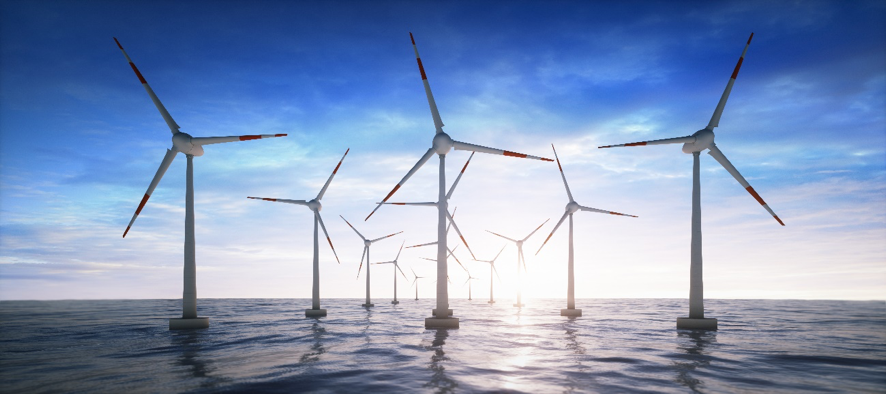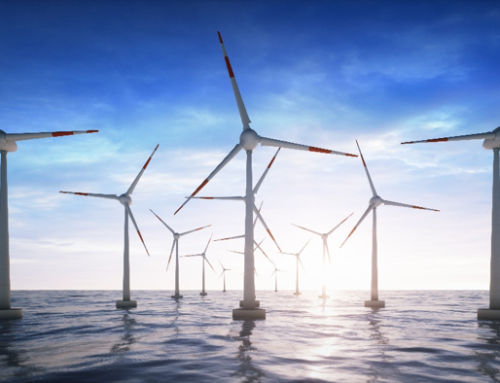
Electricity generation from wind energy has been booming in recent years, driven by the energy transition. While onshore has already experienced some growth for many years now, the complexity of offshore installations has so far been a major drag on offshore projects. But the development and diffusion of new technologies are continually reducing production costs, to the point that global offshore wind power generation is expected to boom by 2023.
To meet the challenges of the energy transition, policy measures are multiplying to develop renewable energies. In this respect, offshore wind has very favourable political support, which is growing and developing well beyond the borders of Europe, the historical cradle of this industry.
The offshore wind market has long been focused on Europe, with the United Kingdom in the lead. The country accounted for 34% of the installed capacity in 2018, closely followed by Germany (28%), In the rest of the world, only China stood out equally (completing the podium with 20%), the remaining 18% being spread over the rest of the world.[i]
European growth is expected to continue at around 3% per year by 2025.1 The UK and Germany will remain the main installers: the first has already announced in 2018 to tender every 2 years this year and the second should review its target of 6 to 20 GW by 2030.2 France should follow suit to catch up and become a major European market by 2020.
But the greatest growth is expected in Asia, the driving force behind the development of offshore wind. This growth will be largely driven by China. For the first time in 2018, the country has installed more capacity than any other country in the world, including the United Kingdom (1.8 GW vs. 1.3 GW3), increasing its installed capacity by 55% compared to the previous year. The Chinese government approved last December the launch of 12 new projects for a total of 13 additional GW.4 Japan5, India and Taiwan have also taken steps to achieve their ambitious goals.
Many projects are also born on the north-eastern coast of the United States, whose implementation is expected for many between 2023 and 2025. The country should know at that time a real « boom », with 1 GW of offshore installations for the production of electricity, almost non-existent today.
The growth of this industry is also due to the growing collaborations between the different actors. The large wind energy companies, both European and Chinese (Orsted, Vattenfall, Goldwind, etc.), bring their expertise to the turbines developed and perfected for years in onshore. Actors historically focused on Oil & Gas activities (Equinor, General Electric, Nexans, etc.) bring their knowledge of offshore installations. These synergies enable the optimization of already mature technologies, reducing costs for a decade now.
Innovative technologies also appear, favoured by strengthened links between large groups, SMEs and start-ups, on all operations: turbines, foundations, maintenance, transmission cables, etc. Europe already has an Innovation Hub dedicated to this industry, the Offshore Wind Infrastructure Application Lab (OWI-Lab). The UK also has its « Offshore Wind Innovation Hub ».
According to the Global Wind Energy Council (GWEC), these advances have contributed to reducing the overall cost of standardized electricity (LCOE) from 180 to 120$/MWh.1 According to IRENA (International Renewable Energy Agency), the average cost of electricity generated by offshore wind could continue to decline by 4% per year until 2022.6
The profitability of projects is increasing, investments, equity investments and acquisitions are intensifying: the German company Reetec (subsidiary of EDF Energies Nouvelles) has for example acquired OffShore Wind Solutions in 2017, when the Danish giant Orsted has its share bought the company Deepwater Wind for more than 400M€ at the end of 2018. Oil & Gas’s historic players also invest heavily, proof that the market is becoming more profitable. Norway’s Equinor (formerly Statoil) is planning to invest more than 900M€ over the next few years for a project off the Canary Islands. Joint ventures are forming, illustrating the growing size and complexity of projects. Engie and EDP (Energias de Portugal) announced in June 2019 to combine their forces and invest 15 billion euros by 2025 in this joint venture dedicated to offshore wind.
Start-ups are not left behind, with sometimes several millions of euros already raised. All technology bricks are subject to interest: floating structures (X1 Wind in Spain, Eolink and Ideol in France), maintenance (Rope Robotics in Denmark, Ping in Australia, etc.), drilling techniques (GBM Works in the country – etc.), etc.
Some challenges remain, in particular the resilience of infrastructures to adapt to harsher climates, further reduce costs, develop appropriate storage solutions, etc. Nevertheless, offshore wind is already in a new phase of development and is expected to grow by 18% annually until 2023.7
1 GWEC – Global Wind Report 2019 (publié en Avril 2019)
2 https://www.offshorewind.biz/2018/12/06/germanys-2030-ow-target-increase-on-the-horizon/
3 https://safety4sea.com/china-leads-offshore-wind-growth-during-2018-report-says/
4 https://www.4coffshore.com/news/china-approves-over-13gw-nid11047.html
6 https://www.offshorewind.biz/2019/05/29/irena-offshore-wind-power-costs-on-downward-path/
7 https://www.technavio.com/report/global-offshore-wind-power-market-industry-analysis





